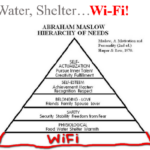You have probably heard by now that enterprise grade 802.11ac chipsets from the chipset manufacturers such as Qualcomm and Broadcom are arriving in what has been dubbed “waves” or phases. Enterprise wave 1 11ac access points started shipping in the second half of 2013 and the majority of the 11ac access points on the market today can be considered wave 1. Wave 2 11ac access points were expected to start shipping in the second half of 2015 (and have begun) but full featured versions aren’t expected until the first half of 2016.
Wave 2 promises to add:
- Data rates upwards of 3.5 Gbps vs 1 Gbps
- 160 MHz channels vs 80 MHz
- More lanes on the highway
- Multi User MIMO (MU-MIMO)
- AP can transmit to multiple clients at the same time (up to 4)
- Standards based Transmit Beamforming (TxBF)
- Focus radio frequency energy at the client
- May require infrastructure upgrades and for some once again expensive hardware controller upgrades. Death to the controller!
- 2.5 to 10 gig switch ports or multiple gig ports with link agg (still being worked out)
- 802.3at PoE+
Like I said above there have been a handful of what have been called wave 2 11ac access point product launches this year, but some may debate if they are truly wave 2? Some might call them “wave 1.5”! All can probably agree that they are not yet fully featured. For example the Ruckus R710 was announced back in April as the industry’s first 11ac wave 2 access point. Ruckus confides “You’ve been forced to make difficult decisions. 2011: buy 802.11n now or wait for 802.11ac? 2013: buy 802.11ac wave 1 or wait for wave 2? 2015: Ruckus is delivering the ultimate wireless access point” but is it the ultimate wave 2 access point or is there more to come early next year? Then came the Aruba 320 announced in May as get this, the industry’s first 11ac wave 2 access point! Then the Cisco 1850 in June and a few others. The common theme with all of these has been that they do not yet have all the features that wave 2 promises to add (listed above).
They don’t yet have support for the promised four Multi-User MIMO (MU-MIMO) clients but instead only three. They don’t yet support 160 MHz channels, although the usefulness of this in the enterprise is likely limited to a remote office with just one AP (given you only have one 160 MHz non-overlapping channel in the US and need DFS support). The other killer app? The speed test! In addition these APs don’t yet have an elegant solution for backhauling the promised more than a gigabit of traffic. They ship with two gigabit interfaces. To realize more than a gig, one would need to run two cables, use two switch ports and enable link aggregation. Ugly! Finally wave 2 11ac is not yet certified for interoperability and few clients are available. The Wi-Fi Alliance has not yet publicly announced an interoperability certification program for 11ac wave 2 products but is expected to do so the first half of next year along with the arrival of full featured 11ac wave 2 products.
So given the fact that 11ac wave 1 was initially offered at a price premium over 11n and that these early wave 2 or what some might call “11ac wave 1.5” products are being offered at a price premium over 11ac wave 1 (premium over the premium!), one must question if it’s worth the premium? The fact of the matter is the 11ac standard was ratified late December 2013, so you are not dealing with draft technology but these early wave 2 or what some might call “wave 1.5” products are brand new and wave 2 11ac is not yet certified for interoperability, not many wave 2 clients exist. The Wi-Fi alliance however did announce interoperability certification in June of 2013 for wave 1 11ac and there are many certified wave 1 clients available today. Also 11ac Wave 1 doesn’t require infrastructure upgrades. You can leverage existing gigabit switch ports and in many cases 802.3af PoE (some may require 802.3at PoE+). Finally 11ac wave 1 three stream products are a small price premium over 11n and in many cases prices have leveled off to be the same or lower than 11n. In addition mid-tier/lower cost wave 1 two stream products have emerged.
11ac wave 1 remains really great for lifecycle upgrades, high user density environments such as stadiums, conference centers, lecture halls and gymnasiums, high throughput applications such as video and applications with large file transfers such as CAD. Don’t wipeout with these early wave 2 or what some might call “wave 1.5” products!







Recent Comments